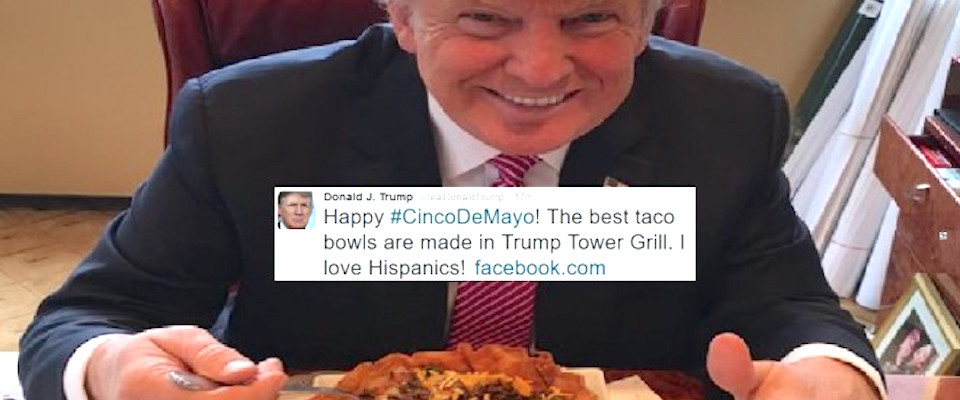Much ado has been made of the Latino demographic in this election year. Democrats see reports of rising voter registration and immigrant naturalization rates among Latinos in Texas, California and elsewhere as good news, given that Latino voters tend to skew Democratic.
Needless to say, Trump Republicans see things differently—most don’t care about a potential Latino voter backlash so much as they care about building what he calls “the beautiful wall” on the Southern border to keep out undocumented immigrants. And leaders of the GOP’s traditional, non-populist wing are simply stricken with foreboding. With at least 17 percent of the population, Latinos constitute the largest minority in the country. From a politician’s perspective, that’s heap of potential voters—too many, a reasonable person might conclude, to risk gratuitously alienating.
But the GOP’s presumptive presidential nominee is secure in his sense of his own manifest destiny, in his belief that he properly defines agendas, not follows them. And if 55 million U.S. residents don’t like it, that’s too bad.
Of all the groups Trump has offended, Latinos perhaps are the most incensed, given the platinum-maned mogul’s incessant calls for building a wall along the Mexico border. He’s also claimed, without evidence, “The Mexican Government is forcing their most unwanted people into the United States. They are, in many cases, criminals, drug dealers, rapists, etc.” A recent CBS News poll found more than four out of five Latino registered voters nationwide viewing Trump unfavorably, which echoes a Field Poll earlier this year that found a similar result among California Latinos.
Thus far this year, California has experienced a “skyrocketing” of new voters registering, according to Paul Mitchell, vice president of the the nonpartisan firm Political Data and an expert in the state’s demographic and voter trends. By analyzing those numbers and comparing them to the first four months of the previous presidential election year of 2012, he notes that California has experienced a 123 percent growth in new registration among Latinos, and a 218 percent growth in new registrants signing up as Democrats.
So just how significant is that rising opposition to Trump?
Pretty darn significant, some pundits think. Recent computer modeling by UCLA political science professor Matt Barreto and David Damore, an associate professor of political science at the University of Nevada, Las Vegas, determined that Trump would need to garner between 42 to 47 percent of the Latino vote in key battleground states to win. That’s a very tall order. In 2012, exit polling indicated that Mitt Romney (who memorably advocated “self-deportation” of undocumented immigrants) captured only between 23 to 27 percent of the Latino vote. And Trump is unlikely to hit even that lackluster figure.
“Trump has said he will mobilize more white voters than ever before, but Ryan knows there are also fewer white voters than ever before. It’s a shrinking demographic.”
“Where a candidate stands on immigration is often a litmus test for Latino voters,” says Christine Trost, the associate director of Cal’s Institute for the Study of Societal Issues. “After the 2012 election, the GOP did an autopsy on the results to determine why they lost. That election was a real wake-up call for the party. George W. Bush did much better among Latinos than Romney, so GOP leaders wanted to find out what had changed. And what they found was that Bush had connected far better than Romney with Latinos on immigration issues.”
By this point, virtually every voter knows where Trump stands on immigration.
“The reason (House Speaker) Paul Ryan isn’t running to embrace Trump is because he has seen the data,” says Trost. “He knows that Trump is heading in the wrong direction. Trump has said he will mobilize more white voters than ever before, but Ryan knows there are also fewer white voters than ever before. It’s a shrinking demographic.”
The party therefore needs to increase its appeal to non-white voters, says Trost, and it’s clear to GOP leaders that Latinos provide the best opportunity for such outreach. Many Latinos traditionally are socially conservative, they’re generally Catholic and family-oriented—in short, they represent the “traditional” values the GOP routinely champions. But nativist tirades from the shoo-in GOP presidential candidate pretty much ensures that the Latino bloc goes Democratic.
“When you demand the deportation of 11 million people, when you boast you’re going to build a massive wall and make Mexico pay for it, then you have a big problem,” says Trost. “That’s not a viable strategy for any party—both for 2016 and the foreseeable future.”

Laura Stoker, a UC Berkeley associate professor of political science, says Latinos don’t necessarily see themselves as hard-core Democrats. Indeed, “They tend to identify themselves as independents. George W. Bush did quite well with Latinos. But since Obama’s first term, they increasingly vote Democratic.”
Latinos tend to vote less than other demographic groups: the California Civic Engagement Project at UC Davis reported that although Latinos made up 27.5 percent of the eligible voter population in California in the last presidential primary, they represented only 12.3 percent of actual voters. But recent spikes in Latino voter registration suggest that could be changing—at least by the general election this November. Nervous California Republicans have an eerie sense of deja vu, recalling that after former GOP Gov. Pete Wilson campaigned for a state proposition to deny government benefits to illegal immigrants, Latinos mobilized and helped transform California from a Republican-friendly state to solidly Democratic.
Trost says research by Lisa Garcia Bedolla, a professor in UC Berkeley’s Graduate School of Education, indicated that Latinos are particular responsive to “interventions,” or contacts by grassroots political organizations.
“Garcia Bedolla published a book in 2012 (Mobilizing Inclusion: Transforming the Electorate through Get-Out-the-Vote Campaigns, co-authored with Melissa R. Michelson) that showed certain types of interventions had a profound effect on Latino voter turn-out,” says Trost. “Every GOP strategist should read that book.”
Second- or third-generation Latinos, who are usually fluent in English and deeply integrated into the larger culture and society, tend to mobilize older first-generation relatives and acquaintances.
Stoker agrees that Latinos can mobilize impressively on specific issues. “Latino communities often are characterized by dense organizational networks,” says Stoker. “When these groups contact people, people tend to respond. Also, voter registration is becoming easier across the country, and that certainly can contribute to greater (Latino) voter registration.”
Finally, she adds, Latinos are often mobilized in an ‘age-reverse’ fashion when hot-button issues like immigration, walls and deportation come to the fore: Second- or third-generation Latinos, who are usually fluent in English and deeply integrated into the larger culture and society, tend to mobilize older first-generation relatives and acquaintances.
Too, efforts are underway by Latino advocacy groups to launch more immigrants into the naturalization process. According to U.S. Citizenship and Immigration Services statistics, there are 13.1 million legal permanent residents in the country. Of that number, 8.8 million could apply for citizenship immediately. Further, 6.1 million of those potential new citizens live in four states: California, New York, Texas and Florida. The first three have fixed political orientations; California and New York are blue and Texas is red. A few million new Democratic voters distributed among them are unlikely to change outcomes. (They could, however, be decisive in down-ballot races: In California, for example, Democrats are within three legislative seats of racking up a super-majority in both houses of the Legislature.)
But Florida is a battleground state, as purple as Prince’s wardrobe. And with its hefty purse of 29 electoral votes, it is a potential game changer. Other states like Nevada and Colorado also have substantial Latino populations, and could tilt red or blue.
 Recognizing this, Stand Up To Hate, a coalition of immigrant rights and advocacy groups, has held 300 events in 14 states and conducted extensive media outreach to jack up naturalization rates among legal permanent residents. These efforts have yielded some dividends. According to federal data, 187,635 permanent residents applied for citizenship between October 2015 and January, a 14.5 percent increase from the same immediately previous period.
Recognizing this, Stand Up To Hate, a coalition of immigrant rights and advocacy groups, has held 300 events in 14 states and conducted extensive media outreach to jack up naturalization rates among legal permanent residents. These efforts have yielded some dividends. According to federal data, 187,635 permanent residents applied for citizenship between October 2015 and January, a 14.5 percent increase from the same immediately previous period.
As noted by the Huffington Post last week, Stand Up To Hate has able to get 12,000 permanent legal residents in the naturalization pipeline since last year. But the coalition has a long way to go, considering that its goal is one million new citizens. As Planas observed, it would take an annual growth rate of 28 percent to hit that mark.
So will the Latino factor be—in Trump’s words—really huge? Will Latinos assure landslide victories for the Democrats, now and forevermore? Not necessarily, as Stoker sees it. First, she says, increased naturalization rates are likely to prove a minor factor. The numbers aren’t all that big, and the naturalization process typically takes six months, meaning the window for the 2016 election is closing rapidly. Second, even though most Latinos now vote Democratic, Democrat-leaning citizens vote less reliably than Republicans. Latinos may be mobilized; Republicans are motivated.
“Also, elections are won state-by-state, not nationally,” says Stoker. “That holds true for presidential elections, given that it’s electoral votes that count. As we saw with George W. Bush in 2000, you can lose the popular vote and still take the presidency. And with many down-ballot races, it’s the concentration of voters in specific states and districts that counts.”
In other words, if Republicans eke out enough votes in red-leaning or purple states—a feat made easier by the fact that GOP lawmakers in most states drew those House district maps to maximize their party’s potency—they can maintain control of both the House of Representatives and the Senate.
Trost, too, declines to handicap the upcoming election.
“Matt Barreto is quite confident of his models, but I’m usually not comfortable making predictions,” she says. “Too many things can happen—or not happen—and that’s especially the case this year. Community commitment and mobilization notwithstanding, nothing really matters but the votes. And you don’t know how people will vote, or how many will vote, until Election Day.”
For more insight into this extraordinary political season, join us in Los Angeles the evening of May 24 for “CALIFORNIA Live! Celebrity Politics in the Digital Age”—moderated by Los Angeles Times reporter David Lazarus, with participants including Variety reporter James Rainey, La Cucaracha cartoonist Lalo Alcarez (all Berkeley alums) and California Magazine Online editor Vicki Haddock.




















